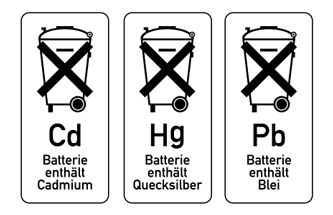Legal
> Take-Back and Recycling
Take-Back and Recycling
Taking back batteries in accordance with the Battery Act (BattG)

According to the BattG, we are obliged to inform our customers about the regulations and obligations for the disposal and return of used batteries and rechargeable batteries.
- End users are obliged to return used batteries and rechargeable batteries in accordance with §11 BattG.
- Batteries and rechargeable batteries containing hazardous substances are labelled with a crossed-out dustbin with the chemical symbol of the heavy metal they contain (Cd for cadmium, Hg for mercury and Pb for lead).
- Batteries and rechargeable batteries must not be disposed of with household waste, but can be returned to us or to any designated collection and return centre free of charge. Our take-back obligation is limited to used batteries of the type that we carry or have carried as new batteries in our range and to the quantity that end users normally dispose of.
Information in accordance with the Electrical and Electronic Equipment Act (ElektroG)
The Electrical and Electronic Equipment Act (ElektroG) contains a large number of requirements for the handling of electrical and electronic equipment. The most important ones are summarised here.
- Separate collection of old appliances
Electrical and electronic equipment that has become waste is referred to as waste equipment. Owners of old appliances must dispose of them separately from unsorted municipal waste. In particular, old appliances do not belong in household waste, but in special collection and return systems - Batteries and rechargeable batteries
As a rule, owners of old appliances must separate old batteries and accumulators that are not enclosed by the old appliance before handing them in at a collection point. - Options for returning old appliances
Owners of old appliances from private households can hand them in at the collection centres of the public waste disposal authorities or at the collection points set up by manufacturers or distributors in accordance with the ElektroG. You can find the collection and take-back centres here: https://www.ear-system.de/ear-verzeichnis/sammel-und-ruecknahmestellen.jsf - Data protection notice
Old appliances often contain sensitive personal data. This applies in particular to information and telecommunications technology devices such as computers and smartphones. In your own interest, please note that each end user is responsible for deleting the data on the old devices to be disposed of. - Meaning of the „crossed-out wheelie bin“ symbol
The crossed-out wheeled bin symbol regularly displayed on electrical and electronic appliances indicates that the appliance in question must be collected separately from unsorted municipal waste at the end of its service life. - Further information
We are a member of the „take-e-back“ system. You can find further information at www.take-e-back.de - According to the provisions of Directive 2008/98/EU on waste and its implementation in the legislation of the Member States of the European Union, waste prevention measures take precedence over waste management measures. In the case of electrical and electronic equipment, waste prevention measures include, in particular, extending the service life of defective equipment by repairing it and selling used equipment in good working order instead of disposing of it. Further information can be found in the waste prevention programme of the federal government with the participation of the federal states:
https://www.bmu.de/publikation/abfallvermeidungsprogramm-des-bundes-unter-beteiligung-der-laender/
